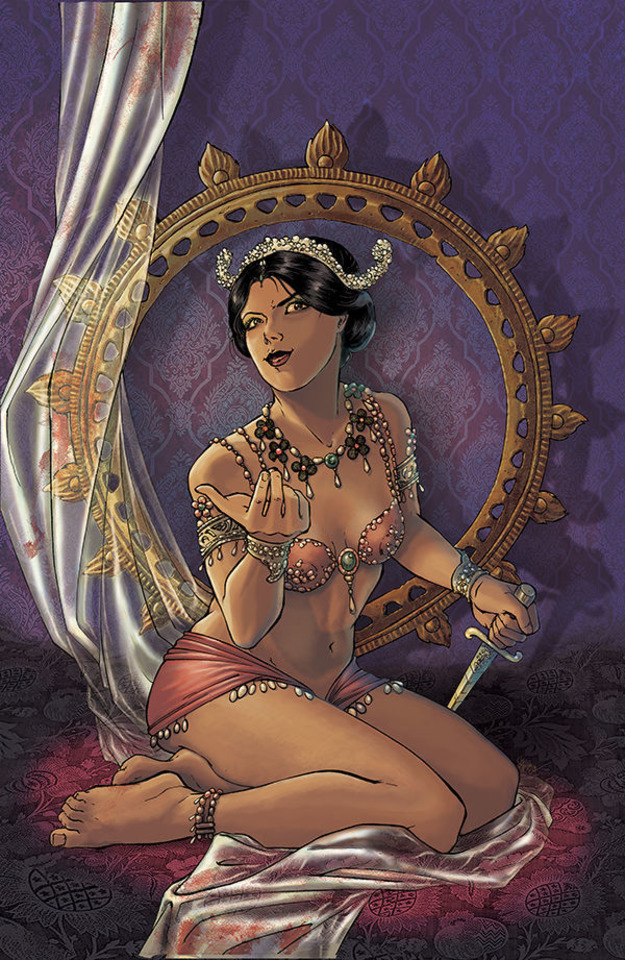In Alan Moore’s Supreme, she joined the time-spanning team of super-teens, The League of Infinity.
Brief History
Mata Hari (1876-1917) was the stage name of Margaretha Geertruida Zelle, a Dutch exotic dancer, courtesan and alleged spy. She was a daughter of businessman Adam Zelle and his first wife Antje van der Meulen. She was born into a wealthy family and attended exclusive schools until the age of 13. However, her father went bankrupt in 1889. Subsequent family problems followed and Margaretha had to move in with various relatives.
Margaretha appeared to escape her problems by marrying Rudolf MacLeod in 1895. He was a Captain in the Dutch colonial Army, well connected with the upper classes and financialy secure. The new couple soon moved to the island of Java, part of the Dutch East Indies (modern Indonesia). They had two children: Norman-John MacLeod (1897-1899) and Louise Jeanne MacLeod (1898-1919). But marrital problems soon started. Rudolf was a hard drinker and physically abusive. The two separated for a few months in 1897. She joined a local dance company at the time and started using the stage name Mata Hari (a local term for the Sun).
Rudolf and Margaretha reconciled for a while. But the death of their son strained their marriage. There were suspicions that the boy was murdered and the couple might have seen each other as responsible. They separated again in 1902, the divorce not finalized until 1907. In 1903, Margareta moved to Paris. She started performing as a circus horse rider under the stage name “Lady MacLeod”. She also worked for a while as an artist’s model. However, neither job was particularly lucrative. She returned to dancing and to the stage name “Mata Hari”. At the time professional dancers such as Isadora Duncan and Ruth St. Dennis were trying to bring new elements to this European art form by studying Asian and Egyptian dances. Having already studied Javan dances, Mata Hari could also incorporate “exotic” elements into her dance. Rising to fame by 1905.
Her dance and stage persona was opensly sensual and suggestively sexual. She was flaunting her body, she flirted with her audience and provoked their staring gazes. She used exotic and eccentric clothing and performed numbers with stripping element. Never completely nude but showing enough skin to captivate her audience. While critics vehemently criticized her and dismissed her artistic merits, by 1910 Mata Hari had become a major influence on stage dance. Off the stage, Mata Hari had a second lucrative career as a courtesan. She had relationships with industrialists, high-ranking military officers, politicians and other influential individuals while performing across Europe.
During World War I (1914-1918), the Netherlands were able to remain neutral. Being a citizen of a neutral state allowed Mata Hari to continue crossing border-lines. Her movements attracted attention and by 1916, there were already suspicions that she was involved in espionage activities. The Scotland Yard innterogated during a tour of the United Kingdom, but came into the conclusion she was affiliated with French Intelligence and released her. In early 1917, French intelligence agents intercepted German messages from Spain. The messages reported on the pro-German activities of a spy called “H-21”. The information included pointed to H-21 being Mata Hari.
On February 13, 1917, Mata Hari was arrested in Paris. She was placed on trial accused of espionage activities, responsible for the death of c. 50,000 military personnel. While the French and British authorities co-operated in this trial, they could only offer the intercepted messages concerning “H-21” and some suspicious activities of the famous dancer. Such as having secret ink in her room. There were no definite evidence that she was “H-21” or that she indeed was affiliated with the Germans. But the court declared her guilty anyway. She was executed by firing squad on October 15, 1917.
While she passed to popular culture as a model for a femme-fatale spy, historians are much less certain of her actual role in the War. She might have been a scapegoat to cover the activities of another alleged double agent, Georges Ladoux. Ladoux was the man supposed to have recruited her into the French Intelligence. The sensational press of the time however presented the idea ” of an exotic dancer working as a lethal double agent, using her powers of seduction to extract military secrets from her many lovers”. There were also various press accounts concerning her courage in facing her own death. While somewhat contradictory, the accounts helped establish her reputation.
By 1931, the film “Mata Hari” had Greta Garbo playing the lead part and further cemented the tale of the femme-fatale into the public conciousness. Mata Hari has went on to appear in films, television series, literature, etc. A century following her death, Mata Hari remains one of the most recognizable persons involved in World War I.

